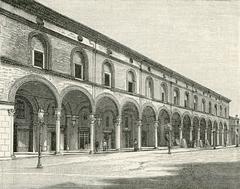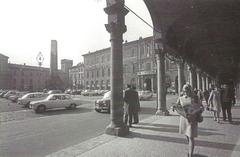Monument To The Fallen Of World War One Imola: Visiting Hours, Tickets, and Travel Guide
Date: 14/06/2025
Introduction
The Monument To The Fallen Of World War One in Imola, Italy, stands as a powerful symbol of sacrifice, remembrance, and national identity. Erected after the Great War, it pays tribute to the local soldiers who gave their lives and offers a space for reflection, education, and community events. With its classical architecture, rich symbolism, and central location, the monument is a must-visit for history enthusiasts, cultural travelers, and anyone interested in Italy’s heritage. This comprehensive guide provides detailed information on the monument’s history, significance, visiting hours, accessibility, nearby attractions, and practical travel tips.
The Proliferation of World War I Monuments in Italy
In the aftermath of World War I, Italy witnessed an unprecedented surge in the construction of war memorials, with estimates ranging from 10,000 to 20,000 monuments across the country (RIHA Journal; Academia.edu). These memorials, found in nearly every town and city, including Imola, reflected a deeply rooted culture of remembrance. Efforts such as the “Progetto Grande Guerra” continue to document and preserve these sites, underscoring their ongoing significance in Italy’s collective memory.
Italy’s Experience in World War I and Local Commemoration
Italy’s participation in the First World War (1915–1918) resulted in over 650,000 military deaths and countless wounded. The trauma of the conflict inspired communities like Imola to establish memorials not only as sites of mourning but as focal points for healing and national unity (RIHA Journal). Local initiatives, often led by families of the fallen, veterans’ associations, and civic groups, played a critical role in creating these monuments, which quickly became central to annual ceremonies and community life.
Fascist Influence and Evolving Symbolism
The rise of Fascism in the 1920s and 1930s shaped the visual and ideological language of many Italian war memorials, including Imola’s. Emphasis shifted toward collective sacrifice and national unity, and monumental forms such as ossuaries became common (RIHA Journal). While the Imola monument maintains its focus on local remembrance, it also reflects broader political and cultural trends of its era.
Architecture, Features, and Symbolism
Design and Materials
Imola’s monument exemplifies classical architectural style, constructed from durable materials like marble and granite. Its symmetrical layout, often featuring a central obelisk or sculptural group elevated on a platform, commands attention and creates a space conducive to reflection.
Sculptural and Decorative Elements
- Soldier Figures: Depict the “simple soldier,” symbolizing the democratization of remembrance.
- Mourning Figures: Represent collective grief and the enduring pain of loss.
- Allegorical Motifs: Use symbols such as laurel wreaths, crosses, and the Italian flag to evoke themes of victory, sacrifice, and peace.
Inscriptions
The monument’s inscriptions honor the fallen by name, personalizing the tragedy and educating visitors about the local impact of the war. Typical dedications frame the sacrifice as noble and eternal, reinforcing civic values and national pride (encyclopedia.1914-1918-online).
Religious and Secular Intersections
A unique aspect of Italian World War I memorials is the blending of religious and secular traditions. The Catholic Church, which initially kept its distance from state-led nationalism, became increasingly involved in commemorative practices after 1918. Many monuments, including Imola’s, were inaugurated with masses and religious rituals and often incorporate Christian iconography, enhancing their cultural resonance (encyclopedia.1914-1918-online).
Community Engagement and Annual Events
The creation and upkeep of the Imola monument have always been community-driven. Today, it remains integral to Imola’s civic life, hosting major ceremonies on November 4th (National Unity and Armed Forces Day) and April 25th (Liberation Day), as well as school visits, performances, and art installations. These events foster a sense of collective ownership and ensure the monument’s ongoing relevance (totalmilitaryinsight.com).
Visiting the Monument: Practical Information
Location and Accessibility
The monument is centrally located in Imola, typically within a public square easily accessible on foot from the Imola railway station or by car. The area is pedestrian-friendly, with paved walkways and ramps to accommodate visitors with mobility challenges.
Visiting Hours and Admission
- Open: 24/7 (outdoor public space)
- Admission: Free
- Recommended Visiting Hours: Daytime visits are encouraged for safety and optimal viewing of details.
Guided Tours
Occasionally, local tourism offices and cultural organizations offer guided tours of the monument and nearby historical sites. These tours provide valuable context and are especially popular during commemorative events.
Visitor Etiquette
- Maintain a respectful, quiet demeanor.
- Remove hats and stand silently during ceremonies.
- Photography is allowed but should be discreet, particularly when others are present or during official events.
Safety and Facilities
Imola is a safe town, and the monument area is well-lit. Cafés, restaurants, and public restrooms are available nearby. During large gatherings, local police ensure public safety.
Nearby Attractions
- Rocca Sforzesca: Medieval fortress with museums and panoramic views.
- Autodromo Enzo e Dino Ferrari: Renowned racing circuit and the Ayrton Senna memorial.
- Local Museums and Churches: Explore Imola’s rich heritage with combined museum tickets (The Silver Nomad).
Travel Tips
- Best Seasons: Spring and autumn offer mild weather and fewer crowds.
- Event Days: November 4th and April 25th feature unique commemorative ceremonies.
- Language: Italian is predominant; tourist offices often have English-speaking staff.
- Accessibility: Most of the site is accessible, but contact the tourism office for detailed accommodations.
Frequently Asked Questions (FAQ)
Q: What are the monument’s visiting hours?
A: The monument is accessible at all times, but daylight hours are recommended.
Q: Is there an admission fee?
A: No, visiting the monument is free of charge.
Q: Are guided tours available?
A: Yes, check with Imola’s tourist office for schedules and bookings.
Q: Is the monument accessible to visitors with disabilities?
A: Yes, with paved pathways and ramps, though some areas may have minor obstacles.
Q: What other sites should I visit in Imola?
A: The Rocca Sforzesca, local museums, and the Autodromo Enzo e Dino Ferrari.
Summary and Final Tips
The Monument To The Fallen Of World War One in Imola is a profound site that embodies Italy’s journey through conflict, remembrance, and national unity. Its accessible location, thoughtful design, and integration into community life make it both a historical landmark and a living part of Imola’s identity. Visitors are encouraged to approach the monument with the respect it deserves, take part in community events, and explore Imola’s other cultural treasures for a holistic experience (Emilia Romagna Turismo; encyclopedia.1914-1918-online).
For the most current information, download the Audiala app, consult local tourism websites, and follow related updates on social media.
Image Caption: The Monument To The Fallen Of World War One in Imola, featuring engraved names and patriotic symbols. (Photo credit: [Insert Photographer/Source])
Alt text: Monument To The Fallen Of World War One in Imola with engraved names and laurel wreaths.
Related articles:
Official tourism website: Imola Tourism Office
Sources and Further Reading
- The Pro Patria Mori cult and memory of the lost generation in the monuments of the fallen soldiers of the Great War in Italy, 2021, Pisani (RIHA Journal)
- Mourning and Cult of the Fallen in Italy, 2020, 1914-1918-online encyclopedia (encyclopedia.1914-1918-online)
- Emilia Romagna Turismo: Terre di Faenza - Memory, History, Places of War and Resistance (Emilia Romagna Turismo)
- The Silver Nomad - Things to do in Imola
- totalmilitaryinsight.com
- nowjourney.com


